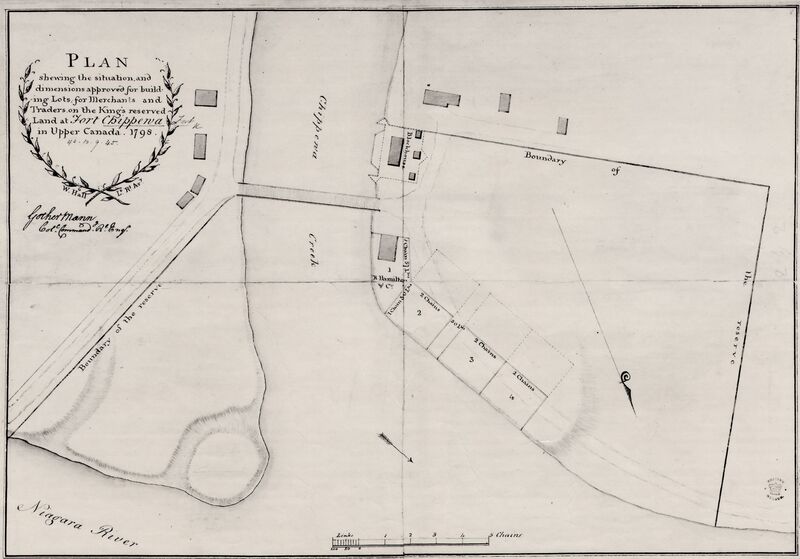Fort Chippawa
Fort Chippawa was built in 1791 at the southern end of the Niagara portage road. It was built as a storage and forwarding depot for government supplies, and not for defensive purposes. Prior to its construction, Fort Schlosser (just opposite Chippawa across the Niagara River), was used as a transhipment point. But the 1783 Treaty of Paris required that land south of the Great Lakes be given to the United States. A decision was made to build a post at the mouth of the Chippawa River which could be used for transporting goods along the Niagara portage road, and housing troops to protect the supplies and the road.
A log blockhouse was built surrounded by a stockade. Other buildings were added sometime before 1800, including an officer's kitchen, bake house, and guard house. Although not designed or built for defensive purposes, the War of 1812 brought additional troops to the Fort. It was recognized that Fort Chippawa was important for maintaining communication between Fort Erie and Fort George. In the event that Fort Chippawa was captured by the Americans, Fort Erie would essentially be isolated.
On May 27, 1813, the Americans attacked in Niagara-on-the-Lake and captured Fort George. The British General John Vincent ordered that Fort Chippawa and Fort Erie be abandoned and that all detachments join him in a retreat to Burlington Heights. After the British retreat, the Americans destroyed Fort Chippawa. However, the Americans were defeated at the battles at Stoney Creek and Beaver Dams, and the British were able to reoccupy much of the Niagara frontier, including Chippawa. They began to reconstruct the fort and strengthen their defences in the area. Meanwhile, the Americans regrouped and occupied Fort Erie on July 3, 1814, advancing towards Chippawa. On July 5, 1814, the British and Americans engaged in battle at Chippawa, with the Americans emerging as the victor. They held possession of the fort for 3 weeks but abandoned it after retreating to Fort Erie following their defeat at the Battle of Lundy's Lane on July 25. In their retreat, they burned the bridge over Chippawa Creek.
The British made preparations to strengthen the defences in Chippawa in anticipation of another attack. During 1814-15, a barracks, storehouse, officer's quarters and earthworks were added and more fortifications were planned. But the end of the war in 1815 made these plans less urgent. Going forward, a decision was made to focus on fortifying other parts of the Niagara frontier and Fort Chippawa quickly fell into disrepair. The village once again became occupied with troops during William Lyon Mackenzie's occupation of Navy Island during the Rebellion of 1837-38. Even after Mackenzie's withdrawal from Navy Island on January 14, 1838, the border remained in a state of turmoil and the British continued to occupy the area for several years. The troops withdrew in 1847 and it appears that Chippawa was no longer used as a military post.

